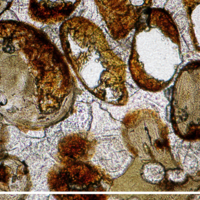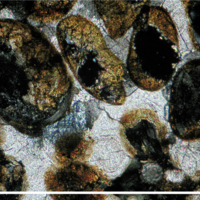- Home
- Rocks
- Type fossils
- Fossil Specimens
- Minerals
- Glossary
- Stratigraphic Chart
- Michel-Levy Chart
- Classification of igneous rocks
- University of Cambridge
- Department of Earth Sciences
- ESC Library
- Moodle
- Sedgwick Museum
- DoITPoMS
- Mindat.org
- Microfossils
- Bryozoans
- Webmineral
- Tree of Life
- CrystalMaker
- Virtual Microscope
L361 - Oolitic ironstone
Hand Specimen
This rock is made up of light grey sub-spherical ooids.
Fine to medium sand grain size.
A few lithic/biogenic fragments.
Dark grey cement.
Small hair-line white veins run through this rock.
Thin-section
Ooids made up of a greenish sheet silicate mineral called chamosite, partially altered to siderite and limonite. Concentric structure. Central cores of fine-grained material.
A layer formed of brown, transparent crystals, sometimes with rhombic cross-sections surrounds the peripheries of many ooids. This is siderite.
Some quartz grains.
The cement is made up mainly of carbonate (siderite), with a small quantity of a green-brown material, which has anomalous interference colours.
This rock is a grainstone (Dunham naming system) or oo-sparite (Folk naming system).
Rock History
Deposited in a moderate energy, marine energy.
Advanced Notes
Chamosite is an Fe-rich chlorite, often greenish. It is a sheet silicate.
Limonite is amorphous or cryptocrystalline, and yellow-brown to brownish-black in colour. It comprises hydrated iron (III) oxides with a range of compositions.
Siderite is iron carbonate (FeCO3). It is often difficult to distinguish siderite from calcite and dolomite optically.
Rock Name
oolitic ironstone
oolite
oolite



